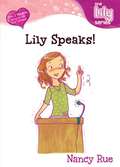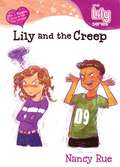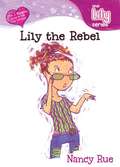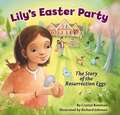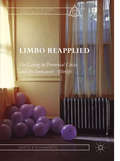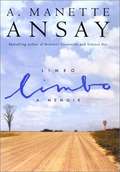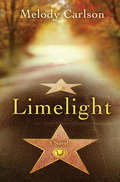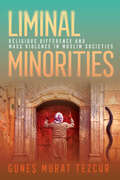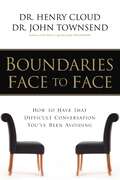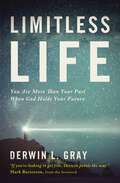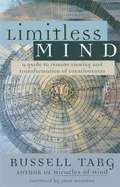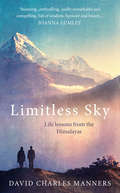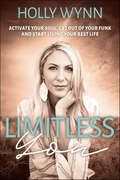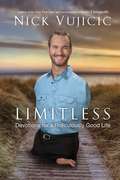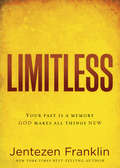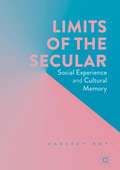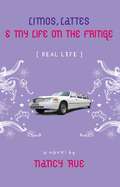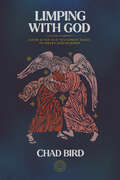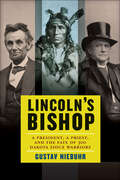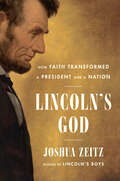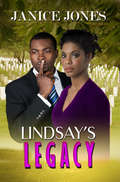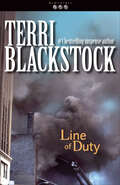- Table View
- List View
Lily Rules!
by Nancy RueLovable Lily dives into leadership and gets swamped until she learns the right use of the spiritual gift of leadership.
Lily Speaks!
by Nancy RueThe sanctity of the Girlz Only Club is at stake! When Lily and Suzy both get selected for the school-wide seventh grade speech contest, an unforeseen battle ensues.
Lily and the Creep
by Nancy RueLily and Shad are into it again. But this time, Lily and her friends are fed up with his teasing, and decide to give Shad a taste of his own medicine. When Lily and her friends play the ultimate prank on Shad, guess who's left to take the fall--Lily.
Lily the Rebel
by Nancy RueLily Robbins has always been a model student, the one who always follows the rules. But suddenly, Lily is questioning the rules, both at home and at school, and it's getting harder to keep her mouth shut about it.
Lily's Easter Party: The Story of the Resurrection Eggs
by Crystal BowmanTogether with the FamilyLife® Resurrection Eggs®, this sweet Easter story will help young children begin to understand the events and importance of the very first Easter.In Lily&’s Easter Party, Lily&’s mom and dad plan an egg hunt that goes beyond chocolate bunnies and eg hunts! Based on the bestselling teaching tool from FamilyLife®, this special neighborhood egg hunt leads Lily, her friends, and young readers on a search for the greatest prize of all: the miraculous story of Jesus&’ death and resurrection, as discovered through symbols presented in the twelve eggs from the Resurrection Eggs®. An explanation of each egg and accompanying scripture reference is included.Lily&’s Easter Party:Perfect Easter gift for young readersUse as a family activity to teach children about the story of EasterUses the FamilyLife® Resurrection Eggs® as a teaching tool
Lily's Passport to Paris
by Nancy RueThis last book in the series includes a special letter to you, the reader, from Nancy Rue. In the letter, you'll learn what happens with Lily and her friends, including Shad, "after the series!" And as an added bonus, Nancy introduces a new character named Sophie, as part of a brand new line of books called FaithGirlz!. So, keep checking us out to find out what's new from Zonderkidz and Nancy Rue!
Lily's in London?!: The Lily Series
by Nancy RueLily's London adventures strengthen her relationship with God as she realizes, more than ever, there are many possibilities for walking her spiritual path in Christ.
Limbo Reapplied: On Living in Perennial Crisis and the Immanent Afterlife (Radical Theologies and Philosophies)
by Kristof K.P. VanhoutteThe observation that our world is signed by a lasting crisis is as much underwritten as it is questioned. This book offers a new and provocative thesis by taking recourse to the religious discourse of Limbo, and by investigating the temporal and spatial structures of crisis and modernity. Modernity reveals itself to be the state of perennial crisis, and we all live in an immanentized state of Limbo.
Limbo: A Memoir
by A. Manette AnsayFrom childhood, acclaimed novelist A. Manette Ansay trained to become a concert pianist. But at nineteen, a mysterious muscle disorder forced her to give up the piano, and by twenty-one, she couldn't grip a pen or walk across a room. She entered a world of limbo, one in which no one could explain what was happening to her or predict what the future would hold. At twenty- three, beginning a whole new life in a motorized wheelchair, Ansay made a New Year's resolution to start writing fiction, rediscovering the sense of passion and purpose she thought she had lost for good. "Writing fiction began for me as a side effect of illness, a way to live beyond my body when it became clear that this new, altered body would be mine to keep. A way to fill the hours that had once been occupied by music. A way to achieve the kind of closure that, once, I'd found in prayer." Limbo takes its title from the Catholic belief in a place between heaven and hell that is neither, one that Ansay imagines as a gray room without walls, a gray floor, a gray bench .... You wouldn't know how long you'd been in that room, or how much longer you had to go." Thirteen years and five books later, still without a firm diagnosis or prognosis, Ansay reflects on the ways in which the unraveling of one life can plant the seeds of another, and considers how her own physical limbo has challenged--in ways not necessarily bad her most fundamental assumptions about life and faith.
Limelight: A Novel
by Melody CarlsonClaudette Fiore had once turned heads and broken hearts. But age has withered that beauty, and a crooked accountant has taken her wealth. Deciding to return to her shabby little hometown, Claudette questions her own values and finds herself wondering if it's too late to change.
Liminal Minorities: Religious Difference and Mass Violence in Muslim Societies (Religion and Conflict)
by Günes Murat TezcürLiminal Minorities addresses the question of why some religious minorities provoke the ire of majoritarian groups and become targets of organized violence, even though they lack significant power and pose no political threat. Güneş Murat Tezcür argues that these faith groups are stigmatized across generations, as they lack theological recognition and social acceptance from the dominant religious group. Religious justifications of violence have a strong mobilization power when directed against liminal minorities, which makes these groups particularly vulnerable to mass violence during periods of political change.Offering the first comparative-historical study of mass atrocities against religious minorities in Muslim societies, Tezcür focuses on two case studies—the Islamic State's genocidal attacks against the Yezidis in northern Iraq in the 2010s and massacres of Alevis in Turkey in the 1970s and 1990s—while also addressing discrimination and violence against followers of the Bahá'í faith in Iran and Ahmadis in Pakistan and Indonesia. Analyzing a variety of original sources, including interviews with survivors and court documents, Tezcür reveals how religious stigmatization and political resentment motivate ordinary people to participate in mass atrocities.
Limites cara a cara: Como tener esa difícil conversación que has estado evitando
by Henry Cloud John TownsendLa dedicatoria especial de este libro nos lo presenta claramente: «Para todos aquellos que quieren hacer de las conversaciones sinceras una parte central de sus relaciones personales». Los autores logran definir las características, beneficios y precauciones de las conversaciones relevantes en 5 partes divididas en 27 capítulos, entre los cuales resaltan los siguientes: «La conversación que puede transformar su vida», «Los beneficios de una buena conversación», «Involúcrate emocionalmente», «Define el problema», «Discúlpate de tu parte en el problema», «Evita usar los “deberías”», «Cómo decirle a la gente lo que quieres decirle» y una sección especial sobre cómo llevar a cabo una conversación difícil con tu cónyuge, tu hijo o hija, tus padres, tus hijos adultos, en el trabajo y con personas en autoridad.
Limitless Life: You Are More Than Your Past When God Holds Your Future
by Derwin L. GrayIs your life limited by labels the world and other people have used to define you? Labels you have internalized and apply to yourself every day. Labels like Afraid. Or Addict. Orphan. Damaged Goods. Failure. Maybe even Religious. These labels might be sewn into your life with such tight little stitches that they feel like a part of you. They feel like they define you. But that's a lie. If you let Him, Jesus can remove those old labels and tattoo new ones onto your soul. Then you'll begin to see yourself as God the Father sees you. The limits will be lifted, and your life will be transformed. It's the truth. Join Pastor Derwin Gray on a fascinating journey into what can happen when you offer your head, your heart, and your hands to the only one who can offer you truly limitless life.
Limitless Mind: A Guide to Remote Viewing and Transformation of Consciousness
by Russell TargFor those interested in psychic phenomena such as remote viewing, out-of-body experiences, precognition and healing at a distance this books is a must read. Targ explores its scientific as well as spiritual implications and offers techniques and exercises to nurture this universal but mostly untapped psychic skills.
Limitless Sky: Life lessons from the Himalayas
by David Charles MannersThis is the remarkable true story of a young man's initiation in the Himalayas. David Manners was trekking in Nepal when he stumbled upon the mountain home of a jhankri, or Nepalese shaman. The jhankri accepted David as his pupil, and so began the next stage of David's extraordinary journey, in which he embarked upon an adventure that was more challenging and, ultimately, life-affirming than anything he could have imagined. In Limitless Sky, David shares the wisdom and insights he learnt from those transformational days in the Himalayas. These include practical guidance on how to live a full and fearless life, how to find happiness and how to live in ways that nurture both ourselves and others. As David reveals, the life lessons he learned amongst the mountains of the Himalayas could benefit us all today.
Limitless You: Activate Your Soul, Get Out of Your Funk and Start Living Your Best Life
by Holly WynnLimitless You helps those seeking to live fully become more self-aware of their emotions and thoughts, by identifying the tricks and traps of the mind and creating the life they deserve to live. Every person is born with a beautiful purpose for their lives; yet past experiences, societal expectations, and accumulated trauma leave many feeling unworthy and fearful of pursuing their passions. The tricks and traps of the brain can convince anyone to move through life with their heads down, eyes glazed, but according to Holly Wynn, human beings aren’t meant to go through the motions!Too many interpret their inner voice saying, “I can’t live like this anymore,” as instruction to remove themselves from this life altogether, rather than an invitation to take steps toward meaningful changes to make life better. In the aftermath of COVID-19’s “new normal,” personal loss and tragedy are far too common, leaving individuals feeling trapped. In Limitless You, Holly Wynn encourages readers to take action, unlocking the door to their heart and embracing the purpose they were meant for.
Limitless: Devotions for a Ridiculously Good Life
by Nick VujicicFrom limbless to limitless - anything is possible with God! Nick Vujicic knows there is no greater hope than trusting in God's plan for your life. Born without arms or legs, Nick has experienced both the peak of hope and the depth of despair. But he has overcome his circumstances and physical limitations by clinging to his faith and understanding the limitless love and power God has for every person. Now he wants you to experience that same reassurance of hope and the power of God, everyday. In these fifty inspirational devotions, Nick shares his most compelling, hard-earned wisdom to help you face obstacles with confidence and courage and point you toward God. Whether you struggle with faith, relationships, career challenges, anger, health concerns, self-esteem, finding balance, or doubt in your dreams, Nick's biblical encouragement and positive attitude will transform your life and show you that you can be limitless because God is limitless. "Now to him who is able to do immeasurably more than all we ask or imagine, according to his power that is at work within us, to him be glory in the church and in Christ Jesus throughout all generations, forever and ever! Amen" (Ephesians 3:20-21).
Limitless: Your Past is a Memory. God Makes All Things New.
by Jentezen FranklinWhen it seems like everything is falling apart, it can be hard to stay focused on the promises of God. With the weight of the world on your shoulders, it becomes very inviting to sit down and give up. Before you know it, doubts, frustration, and bitterness begin to creep in and steal all of the joy and power from your life and your relationship with God. The past is just a memory. God makes all things new. In Limitless best-selling author Jentezen Franklin encourages you to stop listening to the negative voices in your head that say things are never going to get better. You don&’t have to believe that your kids are never going to serve God or you&’ll never regain your health. In this book, you&’ll discover how to: Let go of the baggage and overcome the limits of your past once and for allBlock the enemy&’s access into your life and cancel his assignments to limit youRevive your prayer life and worship times through new levels of intimacy with GodActivate your faith to stop merely talking about miracles and start experiencing themDream God-sized dreams, determine not to become satisfied, and decide to go to the next level in your walk with GodYou don&’t have to live a powerless, lukewarm Christian life. You can be victorious through the power of the Holy Spirit!
Limits of the Secular
by Kaustuv RoyThis book facilitates a missing dialogue between the secular and the transsecular dimensions of human existence. It explores two kinds of limits of the secular: the inadequacies of its assumptions with respect to the total being of the human, and how it curbs the ontological sensibilities of the human. Kaustuv Roy argues that since secular reason of modernity can only represent the empirical dimension of existence, humans are forced to privatize the non-empirical dimension of being. It is therefore absent from the social, imaginary, as well as public discourse. This one-sidedness is the root cause of many of the ills facing modernity. Roy contends that a bridge-consciousness that praxeologically relates the secular and the non-secular domains of experience is the need of the hour.
Limos, Lattes and My Life on the Fringe (Real Life #4)
by Nancy N. RueFrom bestselling author Nancy Rue comes a YA contemporary novel where prom season takes on a deeper meaning, as a girl nominated for prom queen as a joke decides to use the opportunity as a way to empower her fellow classmates. And ends up questioning her self-perceptions in the process.For Tyler Bonning, not caring what others think is her super power. As is her ability to find the perfect, cutting response. All she needs to be happy is her group of equally smart and quirky friends and high grades to get into a good college. Then she&’s nominated for prom queen as a joke.Deciding to make the most of the opportunity—and mask her pain—Tyler starts a Prom for Everyone campaign intended help make the event more affordable. In the process, she discovers the way she&’s perceived by her classmates—as well as her supposedly close friends—may actually be more important than she thought. And she doesn&’t like the person they perceive her to be. With her parents pressuring her to focus on the racial issues at school instead of a frivolous cause, and a growing closeness to a boy who represents everything she once mocked, Tyler questions who she really wants to be. And as prom approaches, she faces her biggest challenge yet. One she can&’t handle on her own.Limos, Lattes & My Life on the Fringe:features a diverse main protagonistfocuses on the ideas of self and identity, and what we let define and divide usprovides an inspirational message for those dealing with tough circumstancesis the final book in the Real Life series, but can also be read as a stand-alone novel
Limping with God: Jacob & The Old Testament Guide to Messy Discipleship
by Chad BirdJacob seems to be anything but a model disciple. He's a trickster, liar, and selfishly ambitious man who fathers children with four women and leads a dysfunctional family rife with jealousy and backstabbing. But Jacob is also Israel, the namesake of the Old Testament community of God, chosen and blessed. As such, this sinner-saint, who limps along with the Lord, burdened by weakness and beset by problems, is the mirror image of all of us who follow Jesus. In his life we see our lives, our struggles, our failures, and most especially the God who loves us and chooses us as his own. As we explore his bio, from his wrangling in the womb with Esau to his death as an old man in Egypt, we will learn more about ourselves and the God who is with us and for us in Jesus the Messiah.
Lincoln's Bishop: A President, A Priest, and the Fate of 300 Dakota Sioux Warriors
by Gustav NiebuhrA history of the Dakota War of 1862, an Episcopal bishop, and his campaign to protect the lives of the Dakota Sioux.It is hard to recall what powerful moral voices Protestant church leaders had in the formative years of the nation. Gustav Niebuhr travels back to the Minnesota frontier of 1862 when Dakota Sioux rose up against pioneering families and slaughtered hundreds. Citizens demanded mass executions and deportations. Into this turmoil stepped Henry Benjamin Whipple, the state’s first Episcopal bishop.Whipple had already loudly decried the crimes and corruption of those managing Indian affairs and warned of calamity. Now he made the case of mercy and a deeper justice, which eventually led to meeting with President Lincoln. Despite being preoccupied with the Civil War, Lincoln was moved to intervene, surprisingly taking the time to review all 303 cases and overturning the death sentence for most of the Indians. Nevertheless, the result was still the largest single execution on American soil.If not for Whipple’s vigorous campaigning, both in state and in Washington, DC, a greater tragedy might well have occurred. His success should haunt us: Where today do we hear these trumpet calls for justice like those given by figures such as Bishop Henry Benjamin Whipple?“[An] enlightening tale of Abraham Lincoln’s other war. . . . A pleasant surprise for the average history buff.” —Kirkus Reviews
Lincoln's God: How Faith Transformed a President and a Nation
by Joshua ZeitzLincoln&’s spiritual journey from spiritual skeptic to America's first evangelical Christian presidentbeliever—a conversion that changed both the Civil War and the practice of religion itself.Abraham Lincoln, unlike most of his political brethren, kept organized Christianity at arm&’s length. He never joined a church and only sometimes attended Sunday services with his wife. But as he came to appreciate the growing political and military importance of the Christian community, and when death touched the Lincoln household in an awful, intimate way, the erstwhile skeptic effectively evolved into a believer and harnessed the power of evangelical Protestantism to rally the nation to arms. The war, he told Americans, was divine retribution for the sin of slavery. This is the story of that transformation and the ways in which religion helped millions of Northerners interpret the carnage and political upheaval of the 1850s and 1860s. Rather than focus on battles and personalities, Joshua Zeitz probes ways in which war and spiritual convictions became intertwined. Characters include the famous—Harriet Beecher Stowe, Frederick Douglass, Henry Ward Beecher—as well as ordinary soldiers and their families whose evolving understanding of mortality, heaven, and mission motivated them to fight. Long underestimated in accounts of the Civil War, religion—specifically evangelical Christianity—played an instrumental role on the battlefield and home front, and in the corridors of government. More than any president before him—or any president after, until George W. Bush—Lincoln harnessed popular religious enthusiasm to build broad-based support for a political party and a cause. A master politician who was sincere about his religion, Lincoln held beliefs that were unconventional—and widely misunderstood then, as now. After his death and the end of an unforgiving war, Americans needed to memorialize Lincoln as a Christian martyr. The truth was, of course, considerably more complicated, as this original book explores.
Lindsay's Legacy
by Janice JonesLindsay Renee Westbrook Taylor, a Christian young woman better known as Nay or Nay-Nay, was married to Shaun Taylor, a notorious Detroit City drug dealer, until his swift and untimely murder. Their marital union was plagued with baby mama drama, infidelity, deadly violence and in-law issues. Now widowed and walking even closer to Christ, Lindsay is remarried to Shaun's former attorney, Cody Vincini. Lindsay feels like she has been blessed with God's ultimate favor in her new life. However, she soon discovers that the sins, secrets, and mistakes of her past are rampantly invading her present and weaving dangerous and destructive paths to her very uncertain future. Will Lindsay stand firm in her faith this time and let God guide her through the dramatic twists and turns of her new life, or will she again let human nature rule her decisions, actions, and reactions? Can she avoid getting pulled back into the situations she barely escaped before and walk away again with everything, including her life, intact?
Line of Duty (Newpointe 911 #5)
by Terri BlackstockAt the request of her many fans—Terri Blackstock revisits the heroic cast of characters in this fifth book in her best-selling Newpointe 911 series In Line of Duty, a bomb explodes at the Icon International building in New Orleans while lawyer Jill Clark Nichols is in the top floor boardroom. The thirty-story building goes up in flames and fire departments from all around the area are called in. The firefighters from Newpointe are especially concerned since they know Jill is inside the building. Dan, her husband, rushes in to save her. But as firefighters work to evacuate the upper floors of the building, a second and third bomb explode, causing the lower floors to cave in. Firefighters and civilians are buried beneath the rubble. When the smoke finally clears, a count is taken. Jill narrowly escapes the chaos of the explosions and fire only to find Dan missing. Were the bombs the act of a terrorist, or a scheme coming from a heart of greed? Can Jill&’s faith carry her through these long days of pain and uncertainty? And will Dan survive this tragedy . . . or sacrifice his life in the line of duty?

